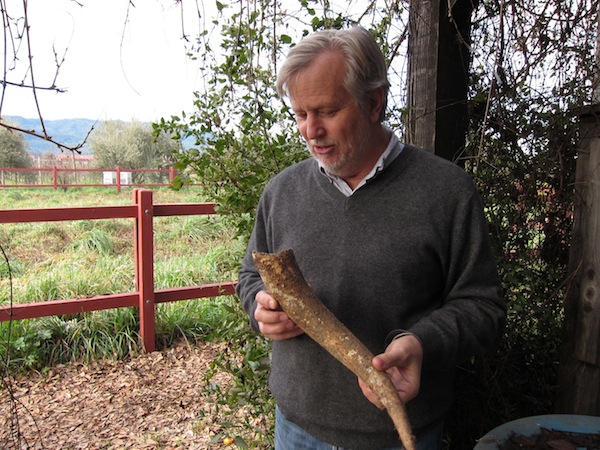Nicolas Joly Savennières and truffled mushroom risotto
Nicolas Joly. Decanter.
Without a doubt, the most influential proponent of biodynamic grape growing in the world is Nicolas Joly, who became converted to the method in the late 1970s when he noticed the soil of his Coulée de Serrant estate in Savennières (in France’s Loire Valley) becoming lifeless, and beneficial insect like ladybugs and other wildlife such as partridges no longer thriving on his property.
Seeking a sensible alternative to chemical herbicides and synthetic applications to save his vineyard, Joly soon discovered the “spiritual science” of the Austrian philosopher/scientist/farmer, Rudolph Steiner, encapsulated in a series of lectures delivered in 1924 called Spiritual Foundations for the Renewal of Agriculture. Completely embracing Steiner’s connecting of “dynamic” relationships between biological and spiritual forces towards the establishment of individual, self-sustaining agricultural systems, Joly has not only been farming biodynamically since the early 1980s, he has been constantly traveling the world delivering seminars on biodynamic viticulture; and in the process, strongly influencing the increasing number of perfectly sane, modern day vintners turning to practical applications of Steiner’s philosophy, however spiritual, anthroposophical, or voodoo-ish (as a recent San Francisco Chronicle story put it) they may be.
Founded in 1928, Demeter International continues to monitor certification of biodynamic growers, issuing its trademark through member associations in key countries (such as Demeter U.S.A.). Why drink biodynamic wine? Because, in fact, they are organic to an nth degree, and hence very much expressive of individual terroir. One of the finer introductions, in fact, is the 2005 Nicolas Joly Savennières Les Clos Sacrés (about $32); the second bottling from this landmark estate (Joly’s top-of-the-line Savennières Coulée de Serrant retails closer to $90 in the U.S.).
Coulée de Serrant
The grape of all white wines carrying the Savennières appellation is Chenin Blanc. But unlike the soft, fruity taste of most Chenin Blanc based whites (like that of the Loire’s nearby Vouvray AC), almost all Savennières is vinified dry as a bone; with noses (as in the ’05 Les Clos Sacrés) leading with intensely earthy, mineral-like or flinty aromas – most certainly reflective of the dark, flaky schist and sandstone dominating the soil of this region – and with the wild honey-ish, green leafy and sweet, yeasty apple-like fragrances of the Chenin Blanc lingering underneath.
Classic Savennières (again, like the ’05 Les Clos Sacrés) is also crisply acidic, stopping just short of sharp, allowing the flavors to flow with long, lively flavors of minerals and sweet (although the wine remains completely dry) apple fruitiness. But for those of you looking for soft, overtly fruity, round or oaky wine: Savennières like that of Joly’s, I’m sorry to say, is not for you.
For those of you curious about sulfites: Like most biodynamic growers, Joly utilizes a minimal amount of sulfites when bottling; but his wines are not, technically, “organic” in respect to zero added sulfites. Joly recognizes the necessity of bottling with at least some sulfites to prevent premature oxidation and produce the kind of wine he likes to produce: capable of maturing, and expanding in flavor and complexity, for up to ten, twenty years after bottling (which, in fact, they do).
What is a perfect dish for Savennières? Many cognoscenti say anything having to do with pungent truffles; which I can’t argue with, since truffles definitely enrich and mingle with the minerally, earthy aromas and flavors of this wine. I am not, however, suggesting that you must go out and buy a pound of truffles. This recipe for Jane's wild mushroom risotto, for instance, artfully utilizes white truffle oil in a perfectly delicious, economical way; and both the wild mushrooms and taleggio cheese in this recipe add umami flavor elements that further amplify a Savennières’ fruit and goût de terroir.
Otherwise, my other favorite match for these dry, minerally, honey scented whites is simply a roast chicken coated with a mixture of honey, black or white truffle oil, butter, and rock salt; which when roasted to a golden brown, sends heavenly aromas throughout the house. Getting hungry and thirsty? I am!






Comments
Post a Comment